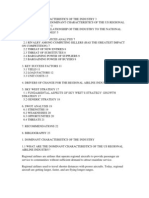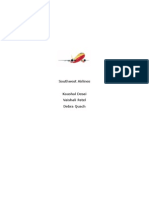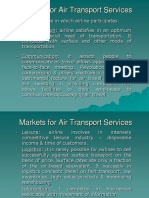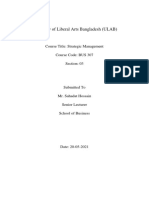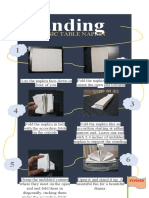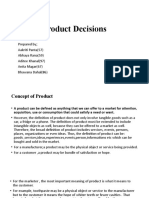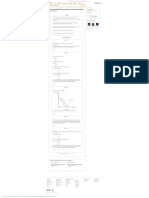0 ratings0% found this document useful (0 votes)
41 viewsPorter'S Five Forces Analysis of The Airline Industry
Porter'S Five Forces Analysis of The Airline Industry
Uploaded by
DENISE MARQUEZThe document analyzes Porter's Five Forces for the airline industry. It finds that the threat of new entrants is low due to high capital requirements to start an airline. The bargaining power of buyers is high since customers can easily compare prices online and face low switching costs. The bargaining power of suppliers like fuel companies and aircraft manufacturers is also high since airlines depend on these inputs over which they have little control. The threat of substitutes is medium as other transportation methods exist but planes are often the fastest. Finally, competitive rivalry in the mature airline industry is intense due to stagnant growth, high fixed costs, and commoditized planes. One complementor is the tourism industry which benefits from airline passengers.
Copyright:
© All Rights Reserved
Available Formats
Download as PDF, TXT or read online from Scribd
Porter'S Five Forces Analysis of The Airline Industry
Porter'S Five Forces Analysis of The Airline Industry
Uploaded by
DENISE MARQUEZ0 ratings0% found this document useful (0 votes)
41 views2 pagesThe document analyzes Porter's Five Forces for the airline industry. It finds that the threat of new entrants is low due to high capital requirements to start an airline. The bargaining power of buyers is high since customers can easily compare prices online and face low switching costs. The bargaining power of suppliers like fuel companies and aircraft manufacturers is also high since airlines depend on these inputs over which they have little control. The threat of substitutes is medium as other transportation methods exist but planes are often the fastest. Finally, competitive rivalry in the mature airline industry is intense due to stagnant growth, high fixed costs, and commoditized planes. One complementor is the tourism industry which benefits from airline passengers.
Original Description:
Original Title
M2 ACTIVITY
Copyright
© © All Rights Reserved
Available Formats
PDF, TXT or read online from Scribd
Share this document
Did you find this document useful?
Is this content inappropriate?
The document analyzes Porter's Five Forces for the airline industry. It finds that the threat of new entrants is low due to high capital requirements to start an airline. The bargaining power of buyers is high since customers can easily compare prices online and face low switching costs. The bargaining power of suppliers like fuel companies and aircraft manufacturers is also high since airlines depend on these inputs over which they have little control. The threat of substitutes is medium as other transportation methods exist but planes are often the fastest. Finally, competitive rivalry in the mature airline industry is intense due to stagnant growth, high fixed costs, and commoditized planes. One complementor is the tourism industry which benefits from airline passengers.
Copyright:
© All Rights Reserved
Available Formats
Download as PDF, TXT or read online from Scribd
Download as pdf or txt
0 ratings0% found this document useful (0 votes)
41 views2 pagesPorter'S Five Forces Analysis of The Airline Industry
Porter'S Five Forces Analysis of The Airline Industry
Uploaded by
DENISE MARQUEZThe document analyzes Porter's Five Forces for the airline industry. It finds that the threat of new entrants is low due to high capital requirements to start an airline. The bargaining power of buyers is high since customers can easily compare prices online and face low switching costs. The bargaining power of suppliers like fuel companies and aircraft manufacturers is also high since airlines depend on these inputs over which they have little control. The threat of substitutes is medium as other transportation methods exist but planes are often the fastest. Finally, competitive rivalry in the mature airline industry is intense due to stagnant growth, high fixed costs, and commoditized planes. One complementor is the tourism industry which benefits from airline passengers.
Copyright:
© All Rights Reserved
Available Formats
Download as PDF, TXT or read online from Scribd
Download as pdf or txt
You are on page 1of 2
MARQUEZ, DENISE S.
PORTER’S FIVE FORCES ANALYSIS OF THE AIRLINE INDUSTRY
THREAT OF NEW ENTRANTS
- This aspect has a low threat for the airline industry. It takes quite some
upfront investments to start an airline company. Like for example, purchasing
aircrafts. Moreover, new entrants need licenses, insurances, and other
qualifications that are not easy to obtain when you are new to the industry.
There are two aspects that do however raise the threat level. First, there are
extremely low switching costs. Second, there are no proprietary products or
services involved.
Even with these two aspects the industry still has a very low threat overall.
Existing firms have a large cost advantage. This industry requires a large amount
of capital and without a strong customer base there will be little to no profit in
the first few years. Existing firms can and will use their high capital to retaliate
against newer firms with whatever means necessary such as lowering prices and
taking a loss.
THE BARGAINING POWER OF BUYERS
- The bargaining power of buyers in the airline industry is high. Customers
can check prices of different airline companies fast through the many online
price comparisons websites such as Skyscanner and Expedia. In addition, there
aren’t any switching costs involved in the process. Customers nowadays are
likely to fly with different carriers to and from their destination if that would lower
the costs. Brand loyalty therefore doesn’t seem to be that high. Some airline
companies are trying to change this with frequent flyer programs aimed at
rewarding customers that come back to them from time to time.
THE BARGAINING POWER OF SUPPPLIERS
- The bargaining power of suppliers in the airline industry can be
considered very high. When looking at the major inputs that airline companies
need, we see that they are especially dependent on fuel and aircrafts. These
inputs however are very much affected by the external environment over which
the airline companies themselves have little control. The price of aviation fuel is
subject to the fluctuations in the global market for oil, which can change wildly
because of geopolitical and other factors. In terms of aircrafts for example, only
two major suppliers exist: Boeing and Airbus. Boeing and Airbus therefore have
substantial bargaining power on the prices they charge.
THE THREAT OF SUBSTITUTES
- This industry has a medium substitute risk level. There are substitutes in the
airline industry. Consumers can choose other form of transportation such as a
car, bus, train, or boat to get to their destination. There is however a cost to
switch. Some means of transportation can be more costly than a plane ticket.
The main cost is time. Planes are by far the fastest form of transportation
available. Airlines surpass all other forms of transportation when it comes to cost,
convenience, and sometimes service. Consumers do sometimes choose other
methods for various reasons such as cost if they are not traveling very far which
raises the risk.
THE INTENSITY OF COMPETITIVE RIVALRY
- The rivalry in the airline industry is very intense for many reasons. The
industry is currently very stagnant. It seems to be in the mature stage of the
business cycle. The number of competitors stays the same in the long run and it
doesn’t seem to be under or over capacitated. The fixed costs are extremely
high in this industry. This makes it hard to leave the industry because they are
probably in long term loan agreements to stay in business. The products involved
or the planes are highly complex which also heightens the competition.
COMPLEMENTORS
- One complementor of the airline industry is the tourism industry. When a
consumer heads to a tourist destination, he or she often gets there on an
airplane. Similarly, whenever a consumer travels on an airplane, that consumer
is most likely going to visit a destination which is a part of the tourism industry,
such as a hotel or a rental car agency.
You might also like
- The Philippine Airline IndustryDocument25 pagesThe Philippine Airline IndustryEliel Daang96% (24)
- Porter's Five Forces - Airline Industry AnalysisDocument4 pagesPorter's Five Forces - Airline Industry AnalysisManan IFtikhar75% (4)
- Void's ICT HandbookDocument40 pagesVoid's ICT Handbookrao muhammad umar farooq100% (1)
- Effect of Price Change On A Substitute Good ProjectDocument7 pagesEffect of Price Change On A Substitute Good ProjectAysha Khan89% (38)
- What Is The Impact of Batching During Peak and Non-Peak Periods?Document2 pagesWhat Is The Impact of Batching During Peak and Non-Peak Periods?Nehir Altıparmak100% (1)
- Mini Case ArticleDocument9 pagesMini Case Articlepaulxu94No ratings yet
- Southwest Airlines - The Industry's Dominant Economic FeaturesDocument5 pagesSouthwest Airlines - The Industry's Dominant Economic FeaturesMevan Goonetilleke100% (1)
- Indigo 5 ForcesDocument3 pagesIndigo 5 Forcesipsa100% (2)
- Ryanair Analysis & ValuationDocument37 pagesRyanair Analysis & ValuationAnna KarousiotiNo ratings yet
- Five Competitive ForcesDocument8 pagesFive Competitive ForcesNguyễn Tâm50% (2)
- Airline Industry: MD Safiur Reza Saddam 0161857Document7 pagesAirline Industry: MD Safiur Reza Saddam 0161857Safiur_AIUBNo ratings yet
- Aviation IndustryDocument5 pagesAviation IndustrySu WenNo ratings yet
- How Attractive Is The European Airline Industry in 2012Document8 pagesHow Attractive Is The European Airline Industry in 2012Askar SerekeNo ratings yet
- The Industry Handbook - AirlineDocument3 pagesThe Industry Handbook - AirlineTran Viet HaNo ratings yet
- Supplier Power: The Industry EnvironmentDocument3 pagesSupplier Power: The Industry EnvironmentUmer RafiqNo ratings yet
- Michael Five Force PorterDocument5 pagesMichael Five Force PorterKingshuk DuttaNo ratings yet
- Threat of New Entrants (Barriers To Entry)Document4 pagesThreat of New Entrants (Barriers To Entry)Sena KuhuNo ratings yet
- InvestopediaDocument2 pagesInvestopediaNazareth HarfoushNo ratings yet
- Porter's Framework of Jet AirwaysDocument3 pagesPorter's Framework of Jet AirwayssahilkuNo ratings yet
- SM Air Industry and Porter 5 ForcesDocument7 pagesSM Air Industry and Porter 5 ForcesMuhammad Umair RajputNo ratings yet
- The Industry HandbookDocument34 pagesThe Industry HandbookslpypndaNo ratings yet
- AMTE 324 Topic 2Document25 pagesAMTE 324 Topic 2Kim RioverosNo ratings yet
- Porters 5 ForcesDocument3 pagesPorters 5 ForcesSahildeep Singh Kohli100% (2)
- Porter's Five Forces: Threat of New EntrantsDocument6 pagesPorter's Five Forces: Threat of New EntrantschocolatelymilkNo ratings yet
- Analytical Tools (Part 2) Porter'sDocument9 pagesAnalytical Tools (Part 2) Porter'sRose Ann GarciaNo ratings yet
- Ryan AirDocument15 pagesRyan Airsushil.saini8667% (6)
- Q1) Is The Budget Airline Segment An Attractive Place To Compete? Answer 1) Competitive RivalryDocument6 pagesQ1) Is The Budget Airline Segment An Attractive Place To Compete? Answer 1) Competitive RivalryRuchin Dwivedi0% (1)
- Micro Economics Assignment Airline Industry SanthoshDocument4 pagesMicro Economics Assignment Airline Industry SanthoshSagar HindoriyaNo ratings yet
- Analyze The Industry Environment of JetBlueDocument8 pagesAnalyze The Industry Environment of JetBlueshivshanker biradarNo ratings yet
- The Industry Handbook: The Airline Industry: Printer Friendly Version (PDF Format)Document21 pagesThe Industry Handbook: The Airline Industry: Printer Friendly Version (PDF Format)Gaurav JainNo ratings yet
- Competition & Strategy: Indigo AirlinesDocument21 pagesCompetition & Strategy: Indigo AirlinesAhmed Dam100% (1)
- Q3 Porter 5 ForcesDocument6 pagesQ3 Porter 5 ForcesDevesh KumarNo ratings yet
- 2015 Aviation TrendsDocument5 pages2015 Aviation TrendsTran Viet HaNo ratings yet
- Porter's 5 Forces and IMCDocument4 pagesPorter's 5 Forces and IMCVanshika ChopraNo ratings yet
- West Jet Encore Porter 5 Forces AnalysisDocument4 pagesWest Jet Encore Porter 5 Forces Analysisle duyNo ratings yet
- Chapter 1 PID - Youssef AliDocument15 pagesChapter 1 PID - Youssef Alianime brandNo ratings yet
- Case01 JetBlue Airways TNDocument16 pagesCase01 JetBlue Airways TNSajid AnothersonNo ratings yet
- SkyWest Online InfoDocument14 pagesSkyWest Online Infobeakerb47No ratings yet
- Case Study China AirlinesDocument5 pagesCase Study China AirlinesMohd FariqNo ratings yet
- AE Week 6 Airline Economics Chapter 3Document63 pagesAE Week 6 Airline Economics Chapter 3Ömer YağmurNo ratings yet
- IBM Airlines 2020Document24 pagesIBM Airlines 2020cozoresNo ratings yet
- Micro Economics Assignment - Airline Industry - SanthoshDocument4 pagesMicro Economics Assignment - Airline Industry - SanthoshSanthosh TholpdayNo ratings yet
- Task 7.0 Pestle: PoliticalDocument11 pagesTask 7.0 Pestle: PoliticalZaharan AhamedNo ratings yet
- Air Asia AssignmentDocument8 pagesAir Asia AssignmentFoo Shu Fong100% (1)
- Assignment 2 (21330)Document6 pagesAssignment 2 (21330)Prasansha ShresthaNo ratings yet
- Southwest 5 FORCESDocument11 pagesSouthwest 5 FORCESBvvss RamanjaneyuluNo ratings yet
- Ch4. Airline Business and Marketing StrategiesDocument29 pagesCh4. Airline Business and Marketing StrategiesHammad RajpootNo ratings yet
- Ryan AirDocument5 pagesRyan Airanuraj.rrNo ratings yet
- Ryanair (Ireland) and Easy Jet (UK)Document8 pagesRyanair (Ireland) and Easy Jet (UK)theyaga_gNo ratings yet
- Asia Airlines Case FinalDocument4 pagesAsia Airlines Case FinalRonak BhattNo ratings yet
- Economic Characteristics of The Air Transportation and Included OrganizationsDocument4 pagesEconomic Characteristics of The Air Transportation and Included OrganizationsVence Dela Tonga PortesNo ratings yet
- AE Week 3 Airline Economics SummaryDocument45 pagesAE Week 3 Airline Economics SummaryÖmer YağmurNo ratings yet
- Porter's Five Forces ModelDocument4 pagesPorter's Five Forces ModelSabaNo ratings yet
- A Complete Analysis of Segmentation, Targeting and Positioning With Special Reference Example of Kingfisher AirlinesDocument21 pagesA Complete Analysis of Segmentation, Targeting and Positioning With Special Reference Example of Kingfisher Airlinesrakeshn_11No ratings yet
- Case Group 6Document7 pagesCase Group 6Israt ShoshiNo ratings yet
- Markets For Air Transport ServicesDocument26 pagesMarkets For Air Transport ServicesMohasin85100% (1)
- Southwest AirlinesDocument29 pagesSouthwest AirlinesLalima Bassi75% (8)
- Master Thesis Airline IndustryDocument4 pagesMaster Thesis Airline Industryerinperezphoenix100% (2)
- 3 Introduction To Airline ManagementDocument22 pages3 Introduction To Airline ManagementRaniaNo ratings yet
- University of Liberal Arts Bangladesh (ULAB) : Course Title: Strategic Management Course Code: BUS 307 Section: 03Document23 pagesUniversity of Liberal Arts Bangladesh (ULAB) : Course Title: Strategic Management Course Code: BUS 307 Section: 03Dhiraj Chandro RayNo ratings yet
- Cruising to Profits, Volume 1: Transformational Strategies for Sustained Airline ProfitabilityFrom EverandCruising to Profits, Volume 1: Transformational Strategies for Sustained Airline ProfitabilityNo ratings yet
- Innovation in Aviation - A Case Study of United AirlinesFrom EverandInnovation in Aviation - A Case Study of United AirlinesNo ratings yet
- Lotus: Advance Table Napkin Folding StepsDocument1 pageLotus: Advance Table Napkin Folding StepsDENISE MARQUEZNo ratings yet
- Standing Fan: Basic Table Napkin Folding StepsDocument1 pageStanding Fan: Basic Table Napkin Folding StepsDENISE MARQUEZNo ratings yet
- About Standing Fan Napkin FoldDocument1 pageAbout Standing Fan Napkin FoldDENISE MARQUEZNo ratings yet
- Marquez's ModelDocument1 pageMarquez's ModelDENISE MARQUEZNo ratings yet
- Summative TestDocument2 pagesSummative TestDENISE MARQUEZNo ratings yet
- Module 1 With HighlightDocument10 pagesModule 1 With HighlightDENISE MARQUEZ100% (2)
- Day Trading Strategies - For Beginners To Advanced Day Traders, Strategy Is KeyDocument16 pagesDay Trading Strategies - For Beginners To Advanced Day Traders, Strategy Is KeysumonNo ratings yet
- Sales & Marketing Strategy: Myskill - IdDocument10 pagesSales & Marketing Strategy: Myskill - IdRafli RidwanNo ratings yet
- ProductDocument38 pagesProductAkriti NiroulaNo ratings yet
- Economics Paper 1 TZ1 SLDocument3 pagesEconomics Paper 1 TZ1 SLKanz MajNo ratings yet
- Beta Capm AptDocument30 pagesBeta Capm AptERICKA MAE BALDEMORNo ratings yet
- Principles of Microeconomics 7Th Edition Gregory Mankiw Test Bank Full Chapter PDFDocument67 pagesPrinciples of Microeconomics 7Th Edition Gregory Mankiw Test Bank Full Chapter PDFRobertMooreyikr100% (12)
- Solved - Ms. Caffeine Enjoys Coffee C and Tea T According To...Document1 pageSolved - Ms. Caffeine Enjoys Coffee C and Tea T According To...Moinul HossainNo ratings yet
- Products and Services & BrandsDocument48 pagesProducts and Services & BrandsX XNo ratings yet
- Powerpoint Slides To Accompany: Marketing Channels, 7 EditionDocument49 pagesPowerpoint Slides To Accompany: Marketing Channels, 7 Editionrukhsar nasimNo ratings yet
- Orderflow Revised CourseDocument3 pagesOrderflow Revised CourseBAE BAENo ratings yet
- Economics Grade 9 Teacher GuideDocument2 pagesEconomics Grade 9 Teacher Guideahmedbarwani23100% (5)
- International Economics II - Chapter 1Document56 pagesInternational Economics II - Chapter 1seid sufiyanNo ratings yet
- Shinsegae Food ResearchDocument3 pagesShinsegae Food Researchapi-550563100No ratings yet
- Supply & Law of SupplyDocument20 pagesSupply & Law of SupplyIshita SharmaNo ratings yet
- Modern Labor Economics Theory and Public Policy 12Th Edition Ehrenberg Test Bank Full Chapter PDFDocument35 pagesModern Labor Economics Theory and Public Policy 12Th Edition Ehrenberg Test Bank Full Chapter PDFbonnie.karow455100% (11)
- Production Management - Challenges and SolutionsDocument1 pageProduction Management - Challenges and SolutionsAryceli AryNo ratings yet
- Envecon 19 20 LECTURE 2 A PDFDocument27 pagesEnvecon 19 20 LECTURE 2 A PDFeggs buyer01No ratings yet
- Econ2123 18fall Practicefinal SolutionDocument17 pagesEcon2123 18fall Practicefinal SolutionwucorlinNo ratings yet
- Problem Set 4 - AnswersDocument14 pagesProblem Set 4 - AnswersUttam BurnwalNo ratings yet
- Damodaran, Aswath. The Cost of IlliquidityDocument48 pagesDamodaran, Aswath. The Cost of IlliquidityAlexandre Berlanda Costa100% (1)
- Exponential Demand FunctionsDocument19 pagesExponential Demand FunctionsDamini ThakurNo ratings yet
- Business Models For DummiesDocument58 pagesBusiness Models For DummiesWilliamNo ratings yet
- PS1Document3 pagesPS1julio_cess2102No ratings yet
- English For Finance, AOFDocument14 pagesEnglish For Finance, AOFLinh NguyenNo ratings yet
- SMA Chapter Fifteen - Short-Term DecisionsDocument95 pagesSMA Chapter Fifteen - Short-Term DecisionsnganduNo ratings yet
- Forex For Beginners To Forex TradingDocument42 pagesForex For Beginners To Forex TradingMake Money BossNo ratings yet
- Guc 61 58 26124 2022-11-17T17 58 57Document46 pagesGuc 61 58 26124 2022-11-17T17 58 57Mariam AhmedNo ratings yet





































